Analysis of Radiation in Medical Imaging: History, Advantages, Risks
VerifiedAdded on 2023/04/20
|8
|2115
|61
Essay
AI Summary
This essay provides a detailed overview of the use of radiation in medical imaging, tracing its history from the discovery of X-rays to modern techniques like CT scans and fluoroscopy. It highlights the advantages of radiation in medical imaging, such as improved diagnostics, cancer treatment planning, and guiding minimally invasive procedures. The essay also addresses the potential adverse effects of radiation exposure, including the increased risk of cancer for both patients and healthcare providers, emphasizing the importance of safety precautions and policies to limit radiation doses. The conclusion acknowledges the significant benefits of radiation in medical imaging while stressing the need for careful management to minimize associated risks. Desklib provides access to this assignment and many other solved assignments for students.
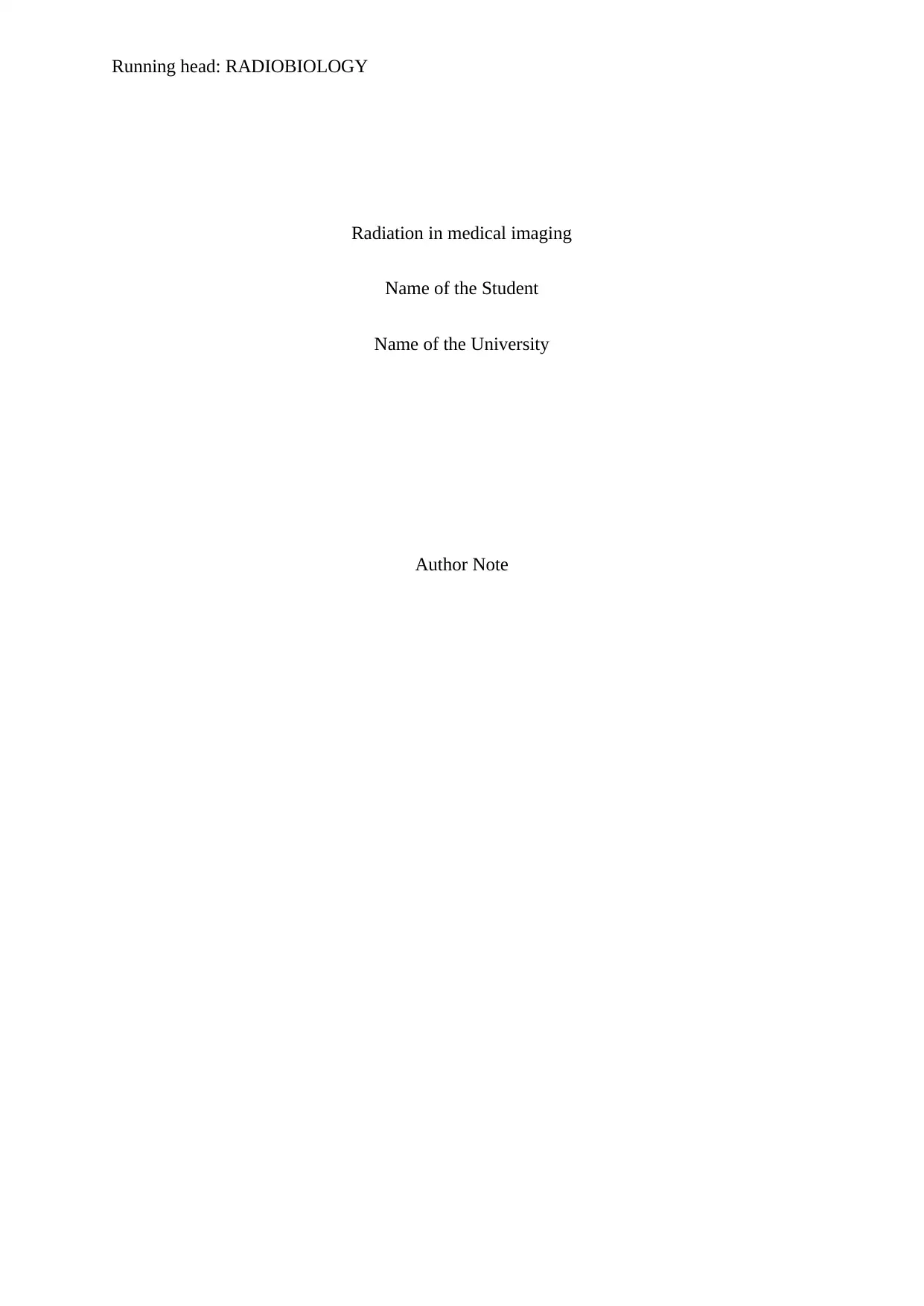
Running head: RADIOBIOLOGY
Radiation in medical imaging
Name of the Student
Name of the University
Author Note
Radiation in medical imaging
Name of the Student
Name of the University
Author Note
Paraphrase This Document
Need a fresh take? Get an instant paraphrase of this document with our AI Paraphraser
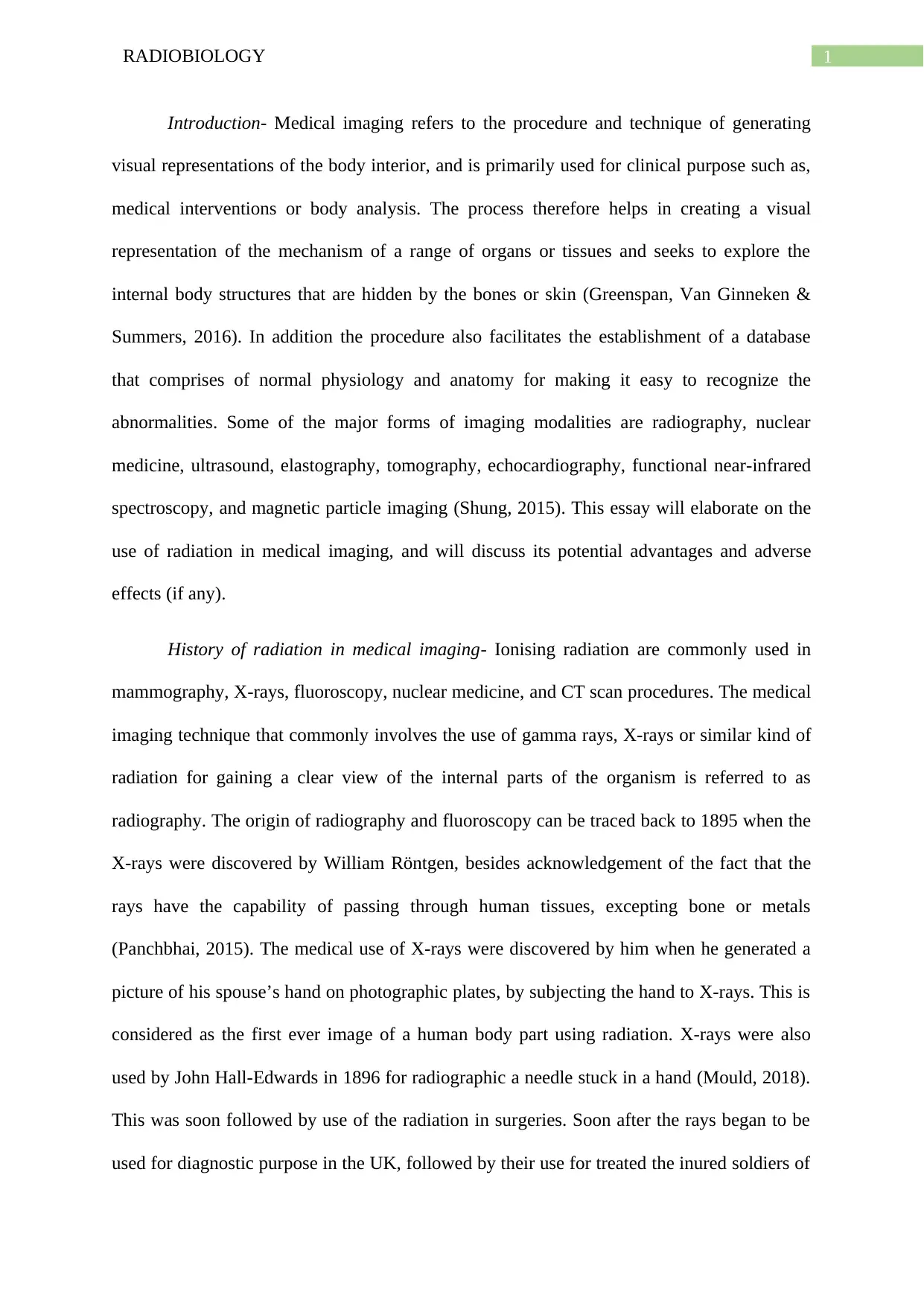
1RADIOBIOLOGY
Introduction- Medical imaging refers to the procedure and technique of generating
visual representations of the body interior, and is primarily used for clinical purpose such as,
medical interventions or body analysis. The process therefore helps in creating a visual
representation of the mechanism of a range of organs or tissues and seeks to explore the
internal body structures that are hidden by the bones or skin (Greenspan, Van Ginneken &
Summers, 2016). In addition the procedure also facilitates the establishment of a database
that comprises of normal physiology and anatomy for making it easy to recognize the
abnormalities. Some of the major forms of imaging modalities are radiography, nuclear
medicine, ultrasound, elastography, tomography, echocardiography, functional near-infrared
spectroscopy, and magnetic particle imaging (Shung, 2015). This essay will elaborate on the
use of radiation in medical imaging, and will discuss its potential advantages and adverse
effects (if any).
History of radiation in medical imaging- Ionising radiation are commonly used in
mammography, X-rays, fluoroscopy, nuclear medicine, and CT scan procedures. The medical
imaging technique that commonly involves the use of gamma rays, X-rays or similar kind of
radiation for gaining a clear view of the internal parts of the organism is referred to as
radiography. The origin of radiography and fluoroscopy can be traced back to 1895 when the
X-rays were discovered by William Röntgen, besides acknowledgement of the fact that the
rays have the capability of passing through human tissues, excepting bone or metals
(Panchbhai, 2015). The medical use of X-rays were discovered by him when he generated a
picture of his spouse’s hand on photographic plates, by subjecting the hand to X-rays. This is
considered as the first ever image of a human body part using radiation. X-rays were also
used by John Hall-Edwards in 1896 for radiographic a needle stuck in a hand (Mould, 2018).
This was soon followed by use of the radiation in surgeries. Soon after the rays began to be
used for diagnostic purpose in the UK, followed by their use for treated the inured soldiers of
Introduction- Medical imaging refers to the procedure and technique of generating
visual representations of the body interior, and is primarily used for clinical purpose such as,
medical interventions or body analysis. The process therefore helps in creating a visual
representation of the mechanism of a range of organs or tissues and seeks to explore the
internal body structures that are hidden by the bones or skin (Greenspan, Van Ginneken &
Summers, 2016). In addition the procedure also facilitates the establishment of a database
that comprises of normal physiology and anatomy for making it easy to recognize the
abnormalities. Some of the major forms of imaging modalities are radiography, nuclear
medicine, ultrasound, elastography, tomography, echocardiography, functional near-infrared
spectroscopy, and magnetic particle imaging (Shung, 2015). This essay will elaborate on the
use of radiation in medical imaging, and will discuss its potential advantages and adverse
effects (if any).
History of radiation in medical imaging- Ionising radiation are commonly used in
mammography, X-rays, fluoroscopy, nuclear medicine, and CT scan procedures. The medical
imaging technique that commonly involves the use of gamma rays, X-rays or similar kind of
radiation for gaining a clear view of the internal parts of the organism is referred to as
radiography. The origin of radiography and fluoroscopy can be traced back to 1895 when the
X-rays were discovered by William Röntgen, besides acknowledgement of the fact that the
rays have the capability of passing through human tissues, excepting bone or metals
(Panchbhai, 2015). The medical use of X-rays were discovered by him when he generated a
picture of his spouse’s hand on photographic plates, by subjecting the hand to X-rays. This is
considered as the first ever image of a human body part using radiation. X-rays were also
used by John Hall-Edwards in 1896 for radiographic a needle stuck in a hand (Mould, 2018).
This was soon followed by use of the radiation in surgeries. Soon after the rays began to be
used for diagnostic purpose in the UK, followed by their use for treated the inured soldiers of
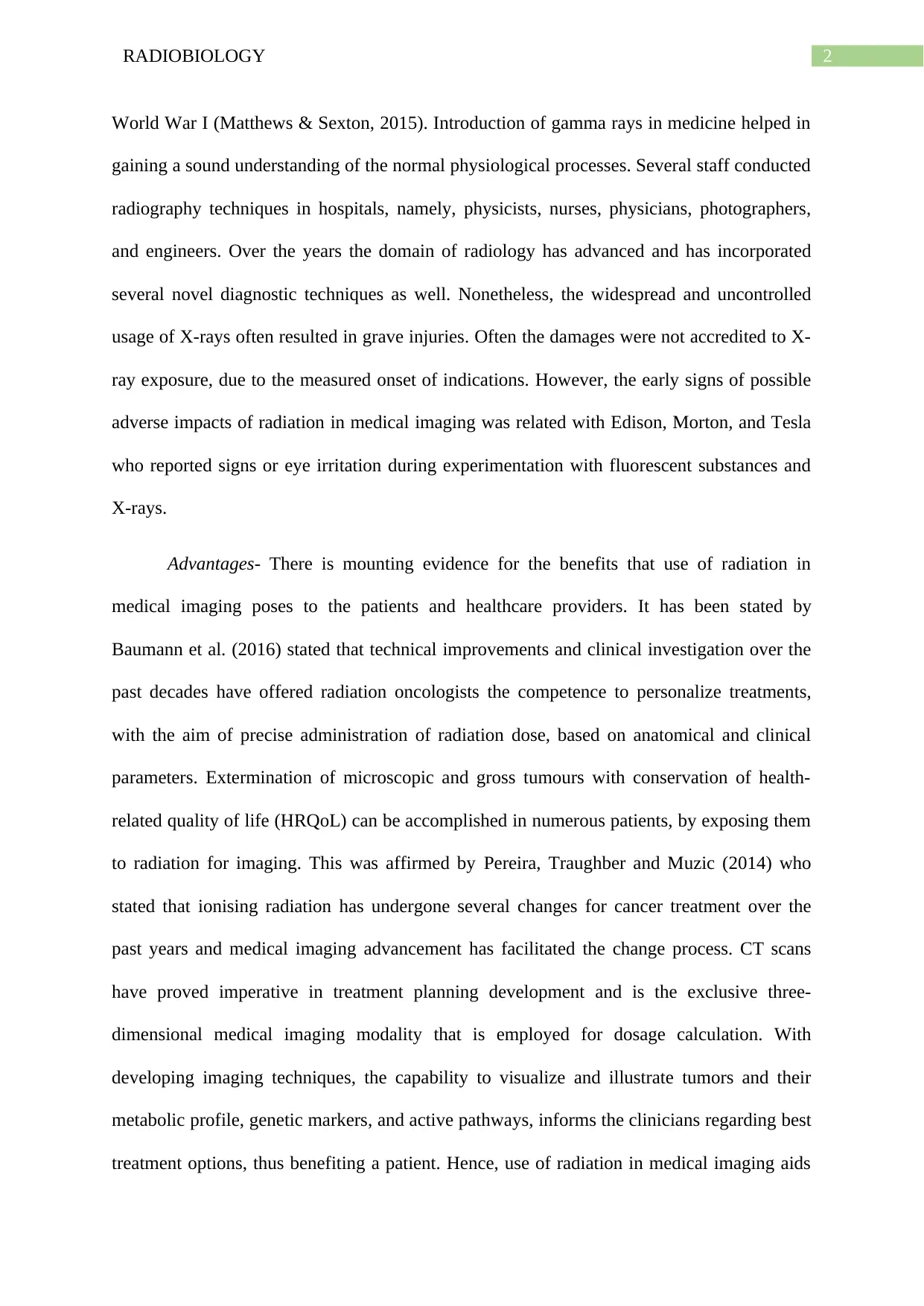
2RADIOBIOLOGY
World War I (Matthews & Sexton, 2015). Introduction of gamma rays in medicine helped in
gaining a sound understanding of the normal physiological processes. Several staff conducted
radiography techniques in hospitals, namely, physicists, nurses, physicians, photographers,
and engineers. Over the years the domain of radiology has advanced and has incorporated
several novel diagnostic techniques as well. Nonetheless, the widespread and uncontrolled
usage of X-rays often resulted in grave injuries. Often the damages were not accredited to X-
ray exposure, due to the measured onset of indications. However, the early signs of possible
adverse impacts of radiation in medical imaging was related with Edison, Morton, and Tesla
who reported signs or eye irritation during experimentation with fluorescent substances and
X-rays.
Advantages- There is mounting evidence for the benefits that use of radiation in
medical imaging poses to the patients and healthcare providers. It has been stated by
Baumann et al. (2016) stated that technical improvements and clinical investigation over the
past decades have offered radiation oncologists the competence to personalize treatments,
with the aim of precise administration of radiation dose, based on anatomical and clinical
parameters. Extermination of microscopic and gross tumours with conservation of health-
related quality of life (HRQoL) can be accomplished in numerous patients, by exposing them
to radiation for imaging. This was affirmed by Pereira, Traughber and Muzic (2014) who
stated that ionising radiation has undergone several changes for cancer treatment over the
past years and medical imaging advancement has facilitated the change process. CT scans
have proved imperative in treatment planning development and is the exclusive three-
dimensional medical imaging modality that is employed for dosage calculation. With
developing imaging techniques, the capability to visualize and illustrate tumors and their
metabolic profile, genetic markers, and active pathways, informs the clinicians regarding best
treatment options, thus benefiting a patient. Hence, use of radiation in medical imaging aids
World War I (Matthews & Sexton, 2015). Introduction of gamma rays in medicine helped in
gaining a sound understanding of the normal physiological processes. Several staff conducted
radiography techniques in hospitals, namely, physicists, nurses, physicians, photographers,
and engineers. Over the years the domain of radiology has advanced and has incorporated
several novel diagnostic techniques as well. Nonetheless, the widespread and uncontrolled
usage of X-rays often resulted in grave injuries. Often the damages were not accredited to X-
ray exposure, due to the measured onset of indications. However, the early signs of possible
adverse impacts of radiation in medical imaging was related with Edison, Morton, and Tesla
who reported signs or eye irritation during experimentation with fluorescent substances and
X-rays.
Advantages- There is mounting evidence for the benefits that use of radiation in
medical imaging poses to the patients and healthcare providers. It has been stated by
Baumann et al. (2016) stated that technical improvements and clinical investigation over the
past decades have offered radiation oncologists the competence to personalize treatments,
with the aim of precise administration of radiation dose, based on anatomical and clinical
parameters. Extermination of microscopic and gross tumours with conservation of health-
related quality of life (HRQoL) can be accomplished in numerous patients, by exposing them
to radiation for imaging. This was affirmed by Pereira, Traughber and Muzic (2014) who
stated that ionising radiation has undergone several changes for cancer treatment over the
past years and medical imaging advancement has facilitated the change process. CT scans
have proved imperative in treatment planning development and is the exclusive three-
dimensional medical imaging modality that is employed for dosage calculation. With
developing imaging techniques, the capability to visualize and illustrate tumors and their
metabolic profile, genetic markers, and active pathways, informs the clinicians regarding best
treatment options, thus benefiting a patient. Hence, use of radiation in medical imaging aids
⊘ This is a preview!⊘
Do you want full access?
Subscribe today to unlock all pages.

Trusted by 1+ million students worldwide
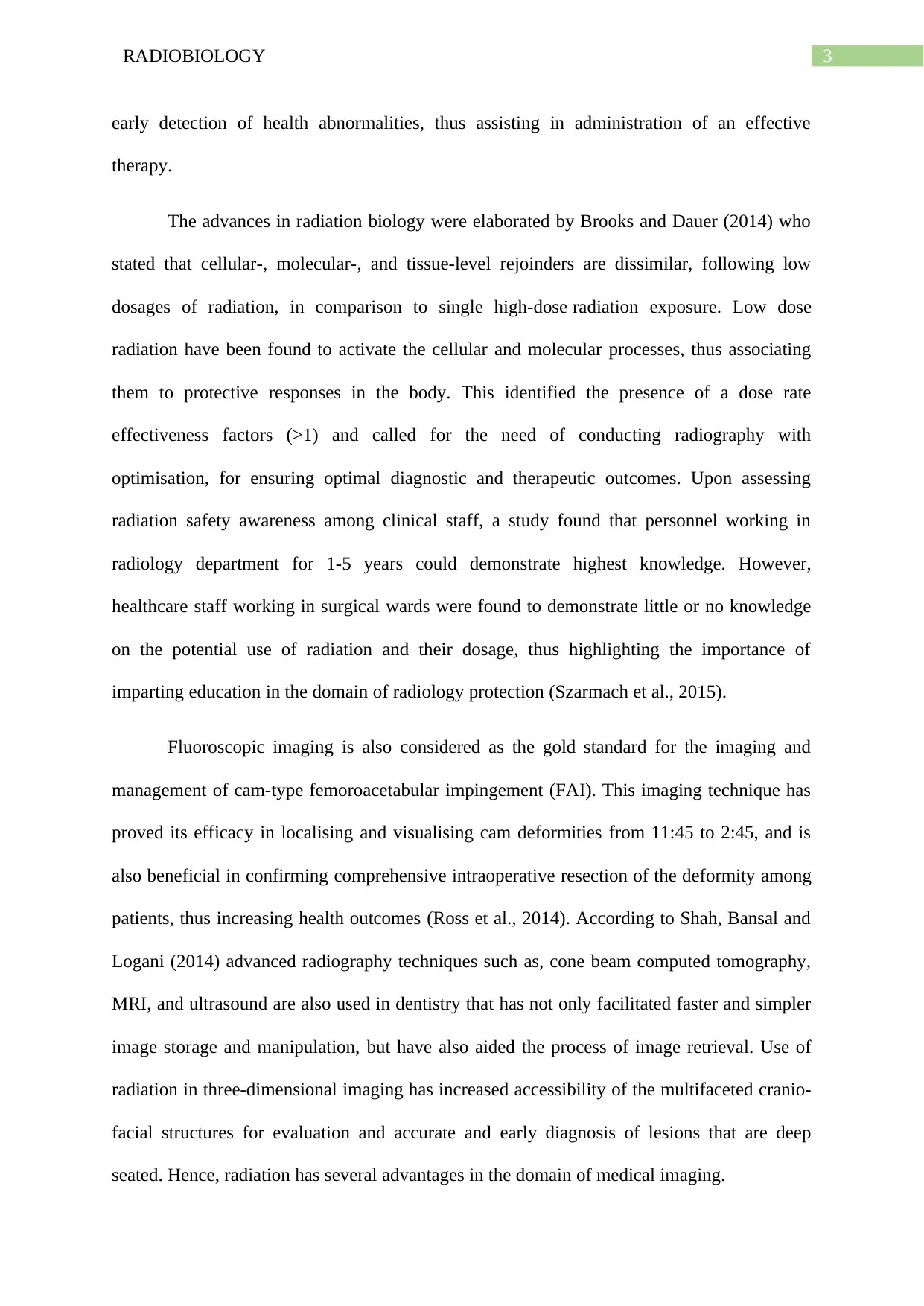
3RADIOBIOLOGY
early detection of health abnormalities, thus assisting in administration of an effective
therapy.
The advances in radiation biology were elaborated by Brooks and Dauer (2014) who
stated that cellular-, molecular-, and tissue-level rejoinders are dissimilar, following low
dosages of radiation, in comparison to single high-dose radiation exposure. Low dose
radiation have been found to activate the cellular and molecular processes, thus associating
them to protective responses in the body. This identified the presence of a dose rate
effectiveness factors (>1) and called for the need of conducting radiography with
optimisation, for ensuring optimal diagnostic and therapeutic outcomes. Upon assessing
radiation safety awareness among clinical staff, a study found that personnel working in
radiology department for 1-5 years could demonstrate highest knowledge. However,
healthcare staff working in surgical wards were found to demonstrate little or no knowledge
on the potential use of radiation and their dosage, thus highlighting the importance of
imparting education in the domain of radiology protection (Szarmach et al., 2015).
Fluoroscopic imaging is also considered as the gold standard for the imaging and
management of cam-type femoroacetabular impingement (FAI). This imaging technique has
proved its efficacy in localising and visualising cam deformities from 11:45 to 2:45, and is
also beneficial in confirming comprehensive intraoperative resection of the deformity among
patients, thus increasing health outcomes (Ross et al., 2014). According to Shah, Bansal and
Logani (2014) advanced radiography techniques such as, cone beam computed tomography,
MRI, and ultrasound are also used in dentistry that has not only facilitated faster and simpler
image storage and manipulation, but have also aided the process of image retrieval. Use of
radiation in three-dimensional imaging has increased accessibility of the multifaceted cranio-
facial structures for evaluation and accurate and early diagnosis of lesions that are deep
seated. Hence, radiation has several advantages in the domain of medical imaging.
early detection of health abnormalities, thus assisting in administration of an effective
therapy.
The advances in radiation biology were elaborated by Brooks and Dauer (2014) who
stated that cellular-, molecular-, and tissue-level rejoinders are dissimilar, following low
dosages of radiation, in comparison to single high-dose radiation exposure. Low dose
radiation have been found to activate the cellular and molecular processes, thus associating
them to protective responses in the body. This identified the presence of a dose rate
effectiveness factors (>1) and called for the need of conducting radiography with
optimisation, for ensuring optimal diagnostic and therapeutic outcomes. Upon assessing
radiation safety awareness among clinical staff, a study found that personnel working in
radiology department for 1-5 years could demonstrate highest knowledge. However,
healthcare staff working in surgical wards were found to demonstrate little or no knowledge
on the potential use of radiation and their dosage, thus highlighting the importance of
imparting education in the domain of radiology protection (Szarmach et al., 2015).
Fluoroscopic imaging is also considered as the gold standard for the imaging and
management of cam-type femoroacetabular impingement (FAI). This imaging technique has
proved its efficacy in localising and visualising cam deformities from 11:45 to 2:45, and is
also beneficial in confirming comprehensive intraoperative resection of the deformity among
patients, thus increasing health outcomes (Ross et al., 2014). According to Shah, Bansal and
Logani (2014) advanced radiography techniques such as, cone beam computed tomography,
MRI, and ultrasound are also used in dentistry that has not only facilitated faster and simpler
image storage and manipulation, but have also aided the process of image retrieval. Use of
radiation in three-dimensional imaging has increased accessibility of the multifaceted cranio-
facial structures for evaluation and accurate and early diagnosis of lesions that are deep
seated. Hence, radiation has several advantages in the domain of medical imaging.
Paraphrase This Document
Need a fresh take? Get an instant paraphrase of this document with our AI Paraphraser
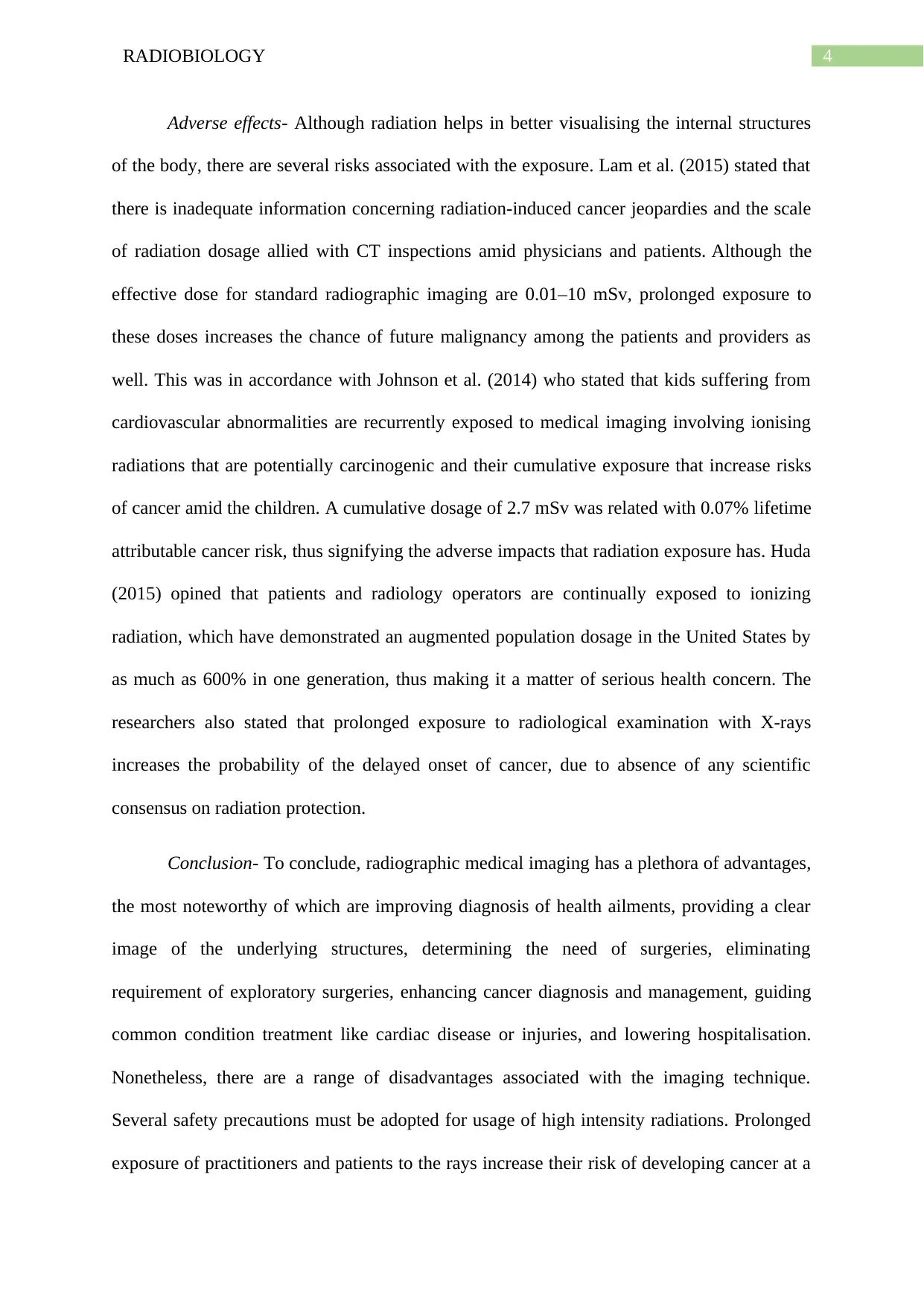
4RADIOBIOLOGY
Adverse effects- Although radiation helps in better visualising the internal structures
of the body, there are several risks associated with the exposure. Lam et al. (2015) stated that
there is inadequate information concerning radiation-induced cancer jeopardies and the scale
of radiation dosage allied with CT inspections amid physicians and patients. Although the
effective dose for standard radiographic imaging are 0.01–10 mSv, prolonged exposure to
these doses increases the chance of future malignancy among the patients and providers as
well. This was in accordance with Johnson et al. (2014) who stated that kids suffering from
cardiovascular abnormalities are recurrently exposed to medical imaging involving ionising
radiations that are potentially carcinogenic and their cumulative exposure that increase risks
of cancer amid the children. A cumulative dosage of 2.7 mSv was related with 0.07% lifetime
attributable cancer risk, thus signifying the adverse impacts that radiation exposure has. Huda
(2015) opined that patients and radiology operators are continually exposed to ionizing
radiation, which have demonstrated an augmented population dosage in the United States by
as much as 600% in one generation, thus making it a matter of serious health concern. The
researchers also stated that prolonged exposure to radiological examination with X-rays
increases the probability of the delayed onset of cancer, due to absence of any scientific
consensus on radiation protection.
Conclusion- To conclude, radiographic medical imaging has a plethora of advantages,
the most noteworthy of which are improving diagnosis of health ailments, providing a clear
image of the underlying structures, determining the need of surgeries, eliminating
requirement of exploratory surgeries, enhancing cancer diagnosis and management, guiding
common condition treatment like cardiac disease or injuries, and lowering hospitalisation.
Nonetheless, there are a range of disadvantages associated with the imaging technique.
Several safety precautions must be adopted for usage of high intensity radiations. Prolonged
exposure of practitioners and patients to the rays increase their risk of developing cancer at a
Adverse effects- Although radiation helps in better visualising the internal structures
of the body, there are several risks associated with the exposure. Lam et al. (2015) stated that
there is inadequate information concerning radiation-induced cancer jeopardies and the scale
of radiation dosage allied with CT inspections amid physicians and patients. Although the
effective dose for standard radiographic imaging are 0.01–10 mSv, prolonged exposure to
these doses increases the chance of future malignancy among the patients and providers as
well. This was in accordance with Johnson et al. (2014) who stated that kids suffering from
cardiovascular abnormalities are recurrently exposed to medical imaging involving ionising
radiations that are potentially carcinogenic and their cumulative exposure that increase risks
of cancer amid the children. A cumulative dosage of 2.7 mSv was related with 0.07% lifetime
attributable cancer risk, thus signifying the adverse impacts that radiation exposure has. Huda
(2015) opined that patients and radiology operators are continually exposed to ionizing
radiation, which have demonstrated an augmented population dosage in the United States by
as much as 600% in one generation, thus making it a matter of serious health concern. The
researchers also stated that prolonged exposure to radiological examination with X-rays
increases the probability of the delayed onset of cancer, due to absence of any scientific
consensus on radiation protection.
Conclusion- To conclude, radiographic medical imaging has a plethora of advantages,
the most noteworthy of which are improving diagnosis of health ailments, providing a clear
image of the underlying structures, determining the need of surgeries, eliminating
requirement of exploratory surgeries, enhancing cancer diagnosis and management, guiding
common condition treatment like cardiac disease or injuries, and lowering hospitalisation.
Nonetheless, there are a range of disadvantages associated with the imaging technique.
Several safety precautions must be adopted for usage of high intensity radiations. Prolonged
exposure of practitioners and patients to the rays increase their risk of developing cancer at a

5RADIOBIOLOGY
later stage in life. Thus, proper policies must be enforced for limiting the radiation dose that
can be sustained by the body.
later stage in life. Thus, proper policies must be enforced for limiting the radiation dose that
can be sustained by the body.
⊘ This is a preview!⊘
Do you want full access?
Subscribe today to unlock all pages.

Trusted by 1+ million students worldwide

6RADIOBIOLOGY
References
Baumann, M., Krause, M., Overgaard, J., Debus, J., Bentzen, S. M., Daartz, J., ... & Bortfeld,
T. (2016). Radiation oncology in the era of precision medicine. Nature Reviews
Cancer, 16(4), 234.
Greenspan, H., Van Ginneken, B., & Summers, R. M. (2016). Guest editorial deep learning in
medical imaging: Overview and future promise of an exciting new technique. IEEE
Transactions on Medical Imaging, 35(5), 1153-1159.
Huda, W. (2015). Radiation risks: what is to be done?. American Journal of
Roentgenology, 204(1), 124-127.
Johnson, J. N., Hornik, C. P., Li, J. S., Benjamin Jr, D. K., Yoshizumi, T. T., Reiman, R.
E., ... & Hill, K. D. (2014). Cumulative radiation exposure and cancer risk estimation
in children with heart disease. Circulation, 130(2), 161-167.
Lam, D. L., Larson, D. B., Eisenberg, J. D., Forman, H. P., & Lee, C. I. (2015).
Communicating potential radiation-induced cancer risks from medical imaging
directly to patients. American Journal of Roentgenology, 205(5), 962-970.
Matthews, S., & Sexton, J. (2015). X-ray and war: an historic tale. ACORN: The Journal of
Perioperative Nursing in Australia, 28(4), 30.
Mould, R. F. (2018). Early Days of X-rays and Radium: Diagnosis, Therapy and Experiment.
In A Century of X-Rays and Radioactivity in Medicine (pp. 36-52). Routledge.
Panchbhai, A. (2015). Wilhelm Conrad Rontgen and the discovery of X-rays: Revisited after
centennial. Journal of Indian academy of oral medicine and radiology, 27(1), 90-90.
Pereira, G. C., Traughber, M., & Muzic, R. F. (2014). The role of imaging in radiation
therapy planning: past, present, and future. BioMed research international, 2014.
References
Baumann, M., Krause, M., Overgaard, J., Debus, J., Bentzen, S. M., Daartz, J., ... & Bortfeld,
T. (2016). Radiation oncology in the era of precision medicine. Nature Reviews
Cancer, 16(4), 234.
Greenspan, H., Van Ginneken, B., & Summers, R. M. (2016). Guest editorial deep learning in
medical imaging: Overview and future promise of an exciting new technique. IEEE
Transactions on Medical Imaging, 35(5), 1153-1159.
Huda, W. (2015). Radiation risks: what is to be done?. American Journal of
Roentgenology, 204(1), 124-127.
Johnson, J. N., Hornik, C. P., Li, J. S., Benjamin Jr, D. K., Yoshizumi, T. T., Reiman, R.
E., ... & Hill, K. D. (2014). Cumulative radiation exposure and cancer risk estimation
in children with heart disease. Circulation, 130(2), 161-167.
Lam, D. L., Larson, D. B., Eisenberg, J. D., Forman, H. P., & Lee, C. I. (2015).
Communicating potential radiation-induced cancer risks from medical imaging
directly to patients. American Journal of Roentgenology, 205(5), 962-970.
Matthews, S., & Sexton, J. (2015). X-ray and war: an historic tale. ACORN: The Journal of
Perioperative Nursing in Australia, 28(4), 30.
Mould, R. F. (2018). Early Days of X-rays and Radium: Diagnosis, Therapy and Experiment.
In A Century of X-Rays and Radioactivity in Medicine (pp. 36-52). Routledge.
Panchbhai, A. (2015). Wilhelm Conrad Rontgen and the discovery of X-rays: Revisited after
centennial. Journal of Indian academy of oral medicine and radiology, 27(1), 90-90.
Pereira, G. C., Traughber, M., & Muzic, R. F. (2014). The role of imaging in radiation
therapy planning: past, present, and future. BioMed research international, 2014.
Paraphrase This Document
Need a fresh take? Get an instant paraphrase of this document with our AI Paraphraser

7RADIOBIOLOGY
Ross, J. R., Bedi, A., Stone, R. M., Sibilsky Enselman, E., Leunig, M., Kelly, B. T., &
Larson, C. M. (2014). Intraoperative fluoroscopic imaging to treat cam deformities:
correlation with 3-dimensional computed tomography. The American journal of
sports medicine, 42(6), 1370-1376.
Shah, N., Bansal, N., & Logani, A. (2014). Recent advances in imaging technologies in
dentistry. World journal of radiology, 6(10), 794.
Shung, K. K. (2015). Diagnostic ultrasound: Imaging and blood flow measurements. CRC
press.
Szarmach, A., Piskunowicz, M., Świętoń, D., Muc, A., Mockałło, G., Dzierżanowski, J., &
Szurowska, E. (2015). Radiation safety awareness among medical staff. Polish
journal of radiology, 80, 57.
Brooks, A. L., & Dauer, L. T. (2014, May). Advances in radiation biology: effect on nuclear
medicine. In Seminars in nuclear medicine (Vol. 44, No. 3, pp. 179-186). WB
Saunders.
Ross, J. R., Bedi, A., Stone, R. M., Sibilsky Enselman, E., Leunig, M., Kelly, B. T., &
Larson, C. M. (2014). Intraoperative fluoroscopic imaging to treat cam deformities:
correlation with 3-dimensional computed tomography. The American journal of
sports medicine, 42(6), 1370-1376.
Shah, N., Bansal, N., & Logani, A. (2014). Recent advances in imaging technologies in
dentistry. World journal of radiology, 6(10), 794.
Shung, K. K. (2015). Diagnostic ultrasound: Imaging and blood flow measurements. CRC
press.
Szarmach, A., Piskunowicz, M., Świętoń, D., Muc, A., Mockałło, G., Dzierżanowski, J., &
Szurowska, E. (2015). Radiation safety awareness among medical staff. Polish
journal of radiology, 80, 57.
Brooks, A. L., & Dauer, L. T. (2014, May). Advances in radiation biology: effect on nuclear
medicine. In Seminars in nuclear medicine (Vol. 44, No. 3, pp. 179-186). WB
Saunders.
1 out of 8
Related Documents
Your All-in-One AI-Powered Toolkit for Academic Success.
+13062052269
info@desklib.com
Available 24*7 on WhatsApp / Email
![[object Object]](/_next/static/media/star-bottom.7253800d.svg)
Unlock your academic potential
Copyright © 2020–2026 A2Z Services. All Rights Reserved. Developed and managed by ZUCOL.





